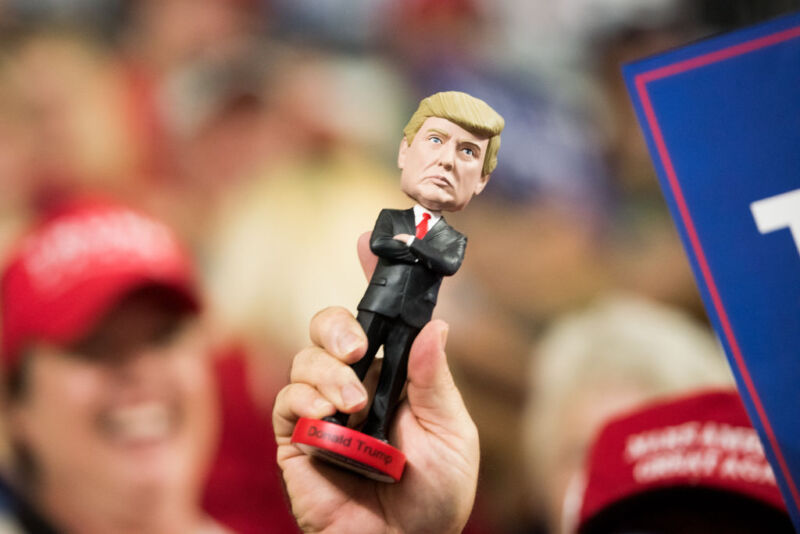
Like any social media platform, Truth Social relies on advertising to drive revenue, but as Twitter’s highly publicized struggle to retain advertisers has shown, it’s hard to attract major brands when a company’s content moderation capabilities appear undependable. That’s likely why Truth Social—which prides itself on sparking an “open, free, and honest global conversation” by largely avoiding content moderation altogether—has seemingly attracted no major advertisers.
A New York Times analysis of hundreds of Truth Social ads showed that the social media platform’s strategy for scraping by is taking ads from just about anyone. Currently, the platform, which was founded by former president Donald Trump, is attracting ad dollars from “hucksters and fringe marketers” who are peddling products like Trump tchotchkes, gun accessories, and diet pills, the Times reported.
In addition to Truth Social’s apparently struggling ad business, SFGate reported in November that Truth Social’s user base also seems to be dwindling. According to The Righting, a group monitoring conservative media, Truth Social traffic peaked last August at 4 million unique visitors but dropped to 2.8 million by October.
Failing to attract ad dollars, losing a huge chunk of traffic, and potentially seeing Trump pivot back to major platforms (he has recently regained access to Twitter and Facebook) could put Truth Social in a dire financial situation. William Wilkinson, a former executive at Trump Media & Technology Group, Truth Social’s parent company, told the Times that the social platform fueled by a $37 million donation is “burning through about $1.7 million each month.”
Trump Media & Technology Group did not immediately respond to Ars’ request for comment.
What’s scaring off major brands?
In August, when Truth Social traffic was at its peak, the platform boasted about its novel ad strategy, hoping to attract more advertisers with its “rapidly growing, highly engaged audience.” Partnering with Rumble Ads—which said in the same press release that it created an “ecosystem” for advertisers seeking to push back against “cancel culture”—Truth Social CEO Devin Nunes predicted that Truth Social would “displace” Big Tech platforms as a preferred advertising space.
That prediction has seemingly not panned out. New York Times reporter Stuart A. Thompson spent several months running a program collecting and analyzing Truth Social ads, concluding that amid Truth Social’s dwindling finances, “ads from major brands are nonexistent on the site.”
Ad experts told the Times that Truth Social major brands are put off because of users posting conspiracy theories and hyperpartisan statements. But the brands could also be avoiding Truth Social simply because there aren’t as many users there to reach compared to Facebook’s billions of users or Twitter’s hundreds of millions. Perhaps most significantly, Truth Social wasn’t attracting enough young audiences for brands to funnel ad spends that way.
Rumble Ad’s advertiser tools could also be partly to blame, the Times reported. The tools make it harder to track an ad’s performance compared to major platforms and seem to limit advertiser abilities to target specific demographics. Rumble did not immediately respond to Ars’ request for comment.
Among the samples the Times collected were ads for “vaccination exemption” cards, kids' guides to "resisting socialism," and plenty of gold-plated and “diamond-dusted” Trump trinkets. While there was nothing misleading about some of these ads, like those pushing Trump hats or bobbleheads, other ads sold fake merchandise. Some clearly fabricated information to make sales, like creating a fake tweet from Joe Biden to push a $2 bill with Trump’s face on it. Others relied on disturbing imagery to sell “miracle cures” like “nature’s oxycontin” or alternative medicines for common ailments like toe fungus, vision impairment, and wrinkles.
Brand safety will always be major brands’ top priority, and it seems that most brands see advertising on Truth Social as playing with fire. Even for the advertisers on Truth Social, the platform may not be doing enough to keep them in business.
The Times pointed to a YouTube video posted by online marketer Maxwell Finn, who claimed to be one of Truth Social’s top advertisers. Finn said in the video that he has spent over $150,000 on Truth Social and has invested in other right-wing-centric platforms. He confirmed that he was frustrated that he had to track his own ad performance on Truth Social—otherwise, he wouldn't know if his ads were generating any sales at all.
“They've gotten incredibly bare-bones, and this is really strange and kind of frustrating because they're all struggling to make money,” Finn said of conservative platforms like Truth Social and Gab.
Ars could not immediately reach Finn for comment, but he potentially represents Truth Social’s ideal advertiser: someone who wants to target a niche user base to sell Trump gear. But Finn suggests that Truth Social isn’t doing enough to build basic advertiser tools that would keep marketers on the platform. Not investing in better ad tools could lead to more financial trouble for Truth Social, as major brands remain shy and Trump eyes spending more time on other platforms ahead of his next presidential bid.
“You have a decent user base, and you have advertisers that want to spend money in your platform, that want to diversify. They want to get off of Facebook, they want to get off of TikTok, they want to get off of YouTube,” Finn said. “That continues to be my biggest gripe.”
reader comments
190